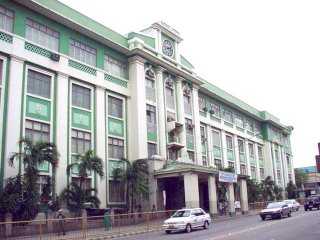There’s something about drinking that makes one merry. Maybe it’s the booze, ice cold, bitter and bubbly. It brings out the poet, the dreamer, the debater and the lover in the tipsy drinker.
So one cold starry, starry dawn I found myself with a glass of beer doing the tagay with fellow artist Kahlil and editors Noel and Jobanni in the eskinita leading to Kamagayan.
It’s an interesting place where the Sun.Star building stands. After work, which is usually twelve or one in the morning, we go out into a street brightly-lit by a sodium lamp.
SunStar’s building stands on Don Pedro Cui and P. del Rosario St. It’s not in the corner (another building stands there) forming an L shape of a building instead of a box. Across it on the opposite side of P. del Rosario St. is Barangay Kamagayan, known for pimps and commercial sex workers or CSWs (to be politically correct) who are made to line up the streets as customers in taxis and expensive cars (as well as dilapidated ones) line up to "appraise" and pick up the girls.
The light dims in the eskinita leading to the heart of Kamagayan.
The eskinita looks innocent in the daytime, hiding the harsh realities that lurk in its corners. In the day, it’s nothing more than a parking place for cars of college kids, office workers and businessmen. But as night falls, it stealthily comes to life.
It was here, surrounded yet oblivious to the traffic of girls and customers brokered by the negotiator-pimps, that Kahlil waxed poetic, Noel sounded mushy and Bani, as always, the nonchalant man-kid. And I, was the foolish critic.
Kahlil and Bani were just fresh from the Cornelio Faigao Writers’ Workshop and our drunken talk span from workshop fellows and writing to Kamagayan (which was the subject of their submitted short stories and Noel’s work in progress) and of all topics, love.
In such a loveless, lonely place, we talked of love, unmindful of the CSWs’ chatter, or the pimps’ frenzied dealings and customers’ hushed bargaining inside tinted SUVs with half drawn windows.
I said I would love to read a story about such a place, if it’s done like Henry Miller’s Quiet Days in Clichy or his Tropic novels. Or the phenomenal movie Moulin Rouge, with a story within a story.
Just then a thought crossed my mind as I looked at the quiet, deserted Don Pedro Cui St. I remember the story I read in Prof. Mike Cullinane’s emails to my brother Genesis, which he also got from Gavin Sanson Bagares, regarding the man after whom the street was named.
I told them, across the street where we were drinking is a street named after someone who chose to stay single the rest of his life after being turned down by the woman he loved.
The philanthrophist Don Pedro Cui vowed never to marry (and he never did) after failing to win the heart of Jorgia Velez, hija natural of Jacinto Velez y Roa.
Jorgia Velez chose to marry Prudencio Sanson Camara with whom she would have three children, among them was Mariano Camara who would be the second husband of Florentino Rallos’ other daughter Concepcion (the other one was the childless Carmen Rallos Sotto)
I said, talking of love, Jorgia Velez looms large in my mind because of the two men who loved her.
One chose not to marry, after she turned him down, because he couldn’t love anybody else.
The other one was the one she chose who devotedly loved her being her husband.
From across Kamagayan where lonely men at a price of a few hundred pesos seek momentary relief from loneliness with equally lonely women, we - tipsy with beer, drunk with literature and mushy with all the lovetalk - stared at a quiet street named after someone who chose not to love anybody else.
It’s sad that she didn’t love him in return. But she didn’t have to. Loving is giving without expecting anything. Even when unreciprocated, loving is already rewardingly humanizing, and redeeming.



 I don’t want to romanticize the way my life revolved around this street but someone else beat me to it. The artist Celso Pepito - who used to have an art gallery in what is now ‘Till Dawn convenience store – used to tell me his fondness for this street.
I don’t want to romanticize the way my life revolved around this street but someone else beat me to it. The artist Celso Pepito - who used to have an art gallery in what is now ‘Till Dawn convenience store – used to tell me his fondness for this street.





 s Al Pacino said in Scent of a Woman, "there’s no prosthetic for that." One returns home with dreams nipped in the bud, idealism demolished after a bout with society’s inequities. And in the end, becoming not so different from the enemy one wished to vanquish. Violence is not only during war but also even at deceptively peaceful yet suppressive times.
s Al Pacino said in Scent of a Woman, "there’s no prosthetic for that." One returns home with dreams nipped in the bud, idealism demolished after a bout with society’s inequities. And in the end, becoming not so different from the enemy one wished to vanquish. Violence is not only during war but also even at deceptively peaceful yet suppressive times.